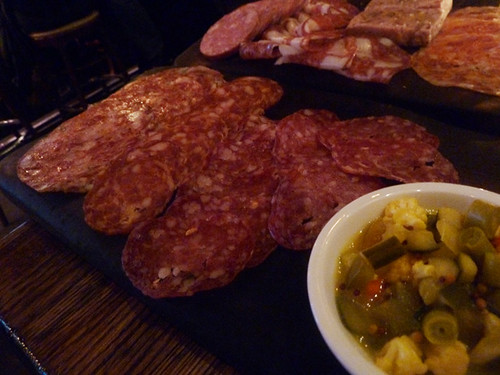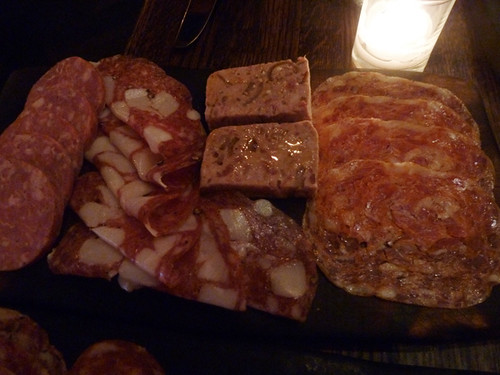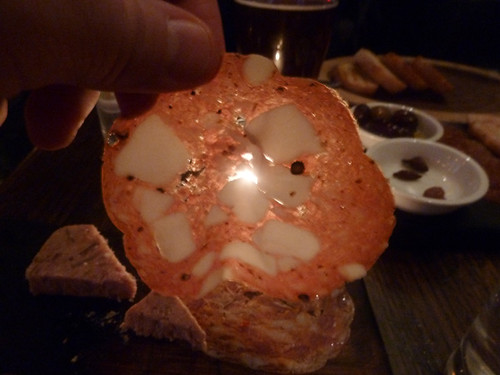
I wrote about Old Town Social and its made-in-house charcuterie a year ago, so I was excited to have a chance to shoot a Key Ingredient there and finally see its fully certified, HACCP-compliant, all-T’s-crossed-with-the-health-department curing room. You can see it at the start of the video:
Okay, so it just looks like any other walk-in fridge, not the gleaming glass Bond-villain vault of meat I imagined. But if there was nothing extraordinary in how it looked, how it smelled was another matter entirely, and those deep, dripping-fat, curing-meat, phantasmagorically primal smells had me convinced that I needed to get back to the restaurant, soon.
Jared explained to us that he had made a number of improvements to the way he was making his charcuterie and that he felt it had come a lot closer to his mostly Italian ideal in the past year. The first issue, he said, is that he feels American charcuterie is too tart, has too much of a lactic acid bite to it; this, he believes, is because of the most commonly used bacterial cultures in the curing process. It’s a bit like how so many American craft beers taste heavily of the same few commercial hop varieties and thus tend to taste a bit alike. So he switched to a different strain of bacteria to use in the curing process and felt like it had produced a mellower, subtler meat flavor in the end result.
Another change he had made had to do with the culture on the outside of the meat— the one that produces the snow-white mold on the skin of certain sausages. This too has a subtle but definite effect on flavor that is responsible, in some mysterious way, for the authentic Italian taste. After a trip to Italy last year he placed an imported sausage in the curing room and its white mold seemed to spread quickly throughout the sausages hanging in there. This, too, he believes has contributed to a flavor improvement closer to his Italian ideal.
My friend Michael Morowitz and I volunteered to help test these theories by eating mass quantities of Jared’s charcuterie last week:

Although my memories of what I ate a year ago are only so clear, I did feel like compared to the general run of in-house charcuterie in Chicago, Jared’s seemed more authentically Italian overall, subtler and more about meat than about the funk of salt and curing. Several were especially outstanding, such as the pressed sopressata above at right, and the toscano with big cubes of fat next to it; we also very much liked the mortadella, which Michael said reminded him of what he and his wife ate on a train-compartment picnic leaving Bologna, and a smoked sopressata, which was an off-menu mistake— a batch of sopressata was made with the wrong curing powder (No. 1 instead of No. 2, which has both nitrates and nitrites for a more effective longer cure). Frankly, it probably would have been fine, but to ensure its safety, they smoked it a bit. Not heavy with smoke, it nevertheless gained a lot of character from the light kiss of smoky flavor.
He’s also just started work on his second restaurant in Chicago (his company has another in San Diego) which will be in the former Marché space on Randolph. Although Old Town Social’s meats will doubtless make an appearance over there, this time the emphasis will be on a broader range of Italian food, with a similarly artisanal approach taken to pasta. He spoke about how flour is one of the stumbling blocks for locavore cooking— you can make all the stuff that goes on the pizza or pasta locally, but there’s no local mill for locally-grown wheat at the specifications a restaurant requires for its range of dishes; you have to buy the same national or imported products as everyone else. So they’re working on building an in-house mill which will allow them to make everything down to “00” pizza flour in house. It sounds as if it could be a big step up for the local Italian food scene; watch for it somewhere around fall to the holidays.
Saying Jared is enthusiastic about his charcuterie hardly covers it; his enthusiasm spreads as quickly as his authentic Italian white mold, and if you’re an amateur charcuterist yourself, it is well worth not only trying his exceptional stuff but finding the opportunity to talk about it with him. (I suggest quieter nights early in the week at this popular Friday/Saturday night drinking spot.) He’s happy to talk shop and share what he knows (we saw a prosciutto ham in his walk-in that he’s hanging for Chris Pandel of The Bristol) and even to share some of the secrets of his products— he’s making enough of the small sopressata to be selling it from the restaurant on the side, and will happily encourage you to buy one and hang it with your own cured meats to catch his Italian mold. Good guy, good meats.



 If you like this post and would like to receive updates from this blog, please subscribe our feed.
If you like this post and would like to receive updates from this blog, please subscribe our feed.




